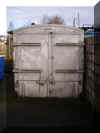






Yes, you read it correctly; PRV Water Tanks; proving not only that PRV was versatile but it wasn't proud either. If it could make a profit from building something, be it a Routemaster or a Water Tank, it would do so.
Brian Carroll kindly pointed out that PRV was responsible for the manufacture of water tanker equipment for the military. It would seem that circa 1953 a scaled down version of a 200 gallon water tank was introduced with the tanker equipment being made by Park Royal Vehicles and Mickleover Transport.
On the Historic Military Vehicle Forum website (a very interesting site by the way) there is an article by Clive Elliott entitled (Army) Water Supply where on page 11 is the detail of PRV's involvement. (The link to the PDF article is is given as there is no obvious link to it from the main site, Ed.)
Does anyone know of further information about these water tanks?
B.R. Type "B" Containers
In 1958, PRV built 50 experimental "B" Type light alloy containers to specification/diagram 3/047 for British Railways. The containers, that would have been shackled to a Conflat "A" rail wagon for carriage, formed the link between traditional "B" boxes and the then new rectangular designs which were stackable. The "B" Type had doors at one end only, however other "B" types, (BD, BK, BM etc.) had different door designs and features for specific uses and were made from timber, be it planks or later ply.
B55897 B, pictured here, seems to have had several owners and is currently used as a store-room on a used car-dealer's plot in Morecambe Lancashire (note: though it looks the same format, 'B55897' is NOT a PRV body number).
Stephen Haley, who kindly advised me of this development and sent in the pictures, comments further that during the 50s/60s there was a lot of container traffic to/from Belfast from Heysham Harbour and considering the branding reads "VICKERS UNDERWATER PIPELINE ENGINEERING TRIALS UNIT" this container may have been involved in sea traffic.
Does anyone know of its history or anything else about these containers?
For more information on conflats, details and a history of containerisation can be found here (http://www.conflat.co.uk/con_hist.html) an interesting site by Phil Hetherington dedicated to the subject.